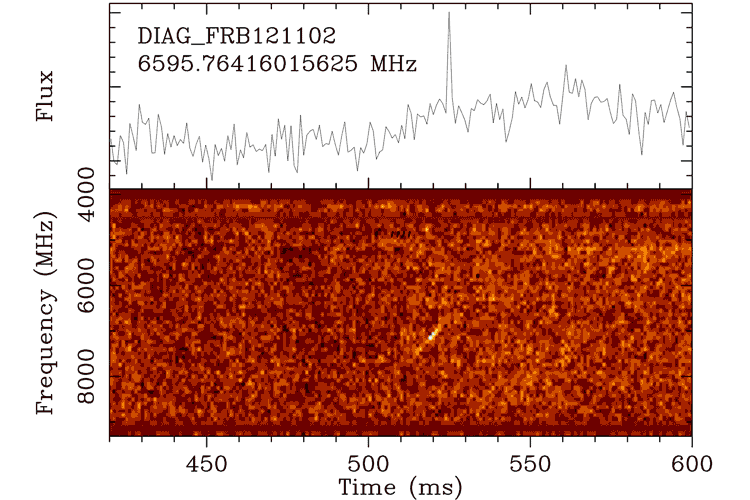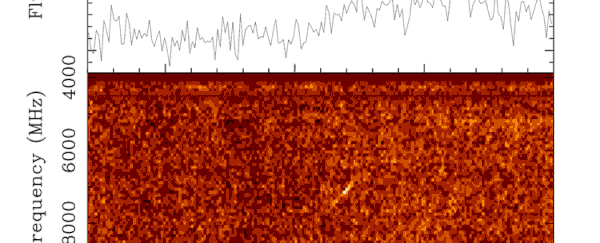In the early hours of Saturday morning, researchers searching the Universe for signs of alien life detected 15 explosive radio signals in the space of just five hours, all coming from a tiny galaxy 3 billion light-years away.
It's the same galaxy we've received repeated signals from in the past, but the blasts, known as ' fast radio bursts' have never been as frequent as these latest discoveries, causing the team to ask other scientists to tune in and help figure out what the hell's causing them.
"Bursts from this source have never been seen at this high a frequency," said Andrew Siemion, director of Breakthrough Listen, an initiative based the University of California, Berkeley, which detected the signals. The group has the aim of searching the Universe for evidence of extraterrestrial life.
Below you can see 14 of the 15 detected bursts across the spectrum.
 Breakthrough Listen
Breakthrough Listen
The reason they're so excited is that fast radio bursts are among the strangest and most explosive phenomena we've detected in our Universe - they can generate as much energy as 500 million Suns in mere milliseconds, but we still have very little insight into what causes them and where they come from.
Before you automatically assume 'aliens', it's likely that these radio signals have an astronomical origin… we're just not quite sure what that could be as yet.
Some of the leading hypotheses for the cause of these repeating signals are highly-magnetic magnetars - a type of neutron star that's surrounded by energetic material. They could also be produced by young neutron stars that emit regular radio pulses as they spin.
And, yes, scientists are even discussing the possibility of aliens - earlier this year, a Harvard team suggested these intense radio bursts could be used to power alien spacecraft.
What makes fast radio bursts so challenging to nail down is that, in the eight years since they were first detected in 2007, astronomers only confirmed a handful of the events, all seeming to occur erratically and originating from different parts of the Universe.
But everything changed in 2015, when researchers confirmed repeated fast radio bursts coming from the same place - a source they've named FRB 121102. It's the only repeating source of fast radio bursts ever detected.
Scientists have since determined that whatever's producing these repeating signals is located in a dwarf galaxy 3 billion light-years from Earth.
But despite having detected more than an incredible 150 fast radio bursts coming from FRB 121102, we're still no closer to understanding what's producing them.
Which is why this latest recording of a rapid-fire 15 radio bursts being emitted by the galaxy over just a few hours is such a big deal.
These latest signals were picked up in the early hours of Saturday 26 August, by the Green Bank Telescope in West Virginia, which was pointed at FRB 121102.
Over a five-hour period, the instrument recorded 400 terabytes of data across the entire 4 to 8 GHz frequency band.
When the Breakthrough Listen researchers analysed this data, they were surprised to find not one, but 15 distinct fast radio bursts coming from the source.
To put that into perspective, it took 83 hours of observing time over six months in 2016 to detect just nine bursts from FRB 121102.
The researchers were able to further confirm these signals were coming from the same dwarf galaxy as FRB 121102 by examining their dispersal - an indicator of how far a signal has travelled before reaching us.
Not only were these fast radio bursts incredibly rapid, but they were also emitted at a higher frequency than previously observed signals, with the brightest emission occurring at around 7 GHz.
"These observations may indicate FRB 121102 is currently in a heightened activity state, and follow-on observations are encouraged, particularly at higher radio frequencies," the team wrote in the Astronomer's Telegram on Monday.
"As well as confirming that the source is in a newly active state, the high resolution of the data obtained by the Listen instrument will allow measurement of the properties of these mysterious bursts at a higher precision than ever possible before," said the Breakthrough Listen researcher who first detected the increased activity, Vishal Gajjar.
"The extraordinary capabilities of the backend receiver, which is able to record several gigahertz of bandwidth at a time, split into billions of individual channels, enable a new view of the frequency spectrum of FRBs, and should shed additional light on the processes giving rise to FRB emission."
So what does the latest data tell us about the potential sources of fast radio bursts?
The quick succession of these blasts makes it unlikely that the repeated radio bursts are being caused by cataclysmic events such as dying black holes.
To be clear, that doesn't rule out the possibility that those dramatic events are producing one-off fast radio bursts - these repeating signals could have an entirely different source.
And what about the alien-shaped elephant in the room? With such an out-there hypothesis, we'd need to confidently rule out every other natural astronomical option available, and the data available doesn't allow us to do that.
Plus, the Breakthrough Listen team points out that when the pulses left their host galaxy, our Solar System would have been less than 2 billion years old - a billion years before even the simplest multicellular life began to evolve on Earth - so we wouldn't have been the most lucrative target for intelligent life out there.
But whatever is causing these repeated radio bursts, these latest observations will hopefully take us one step closer to figuring it out.
"Whether or not fast radio bursts turn out to be signatures of extraterrestrial technology, Breakthrough Listen is helping to push the frontiers of a new and rapidly growing area of our understanding of the universe around us," said Siemion.
The team has reported their initial observations in the Astronomer's Telegram, and are currently writing the results up in more detail for consideration in a peer-reviewed journal.
